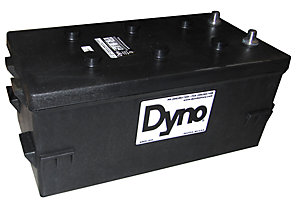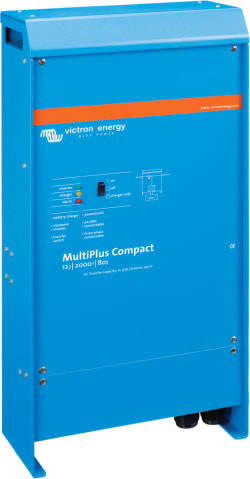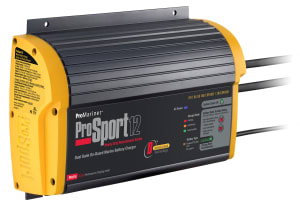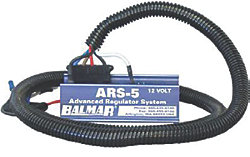Charging a Marine Battery
 You've just bought and installed a brand new bank of batteries and you want to make sure you treat them well to get the most out of your investment. So what do you need to understand to make sure those batteries have a long life? This Navigator will discuss battery charging do's and don'ts and how to make sure you help those batteries live up to their expected cycle life rating. If you don't know much about batteries, we suggest you read our other Navigators listed at the end of this article before you continue reading here.
You've just bought and installed a brand new bank of batteries and you want to make sure you treat them well to get the most out of your investment. So what do you need to understand to make sure those batteries have a long life? This Navigator will discuss battery charging do's and don'ts and how to make sure you help those batteries live up to their expected cycle life rating. If you don't know much about batteries, we suggest you read our other Navigators listed at the end of this article before you continue reading here.
How Low Can You Go?
No one likes spending a lot of time charging their batteries – but it's important to understand how low we can go (discharge wise) between charges without damaging our investment. The first thing to understand is that the more “discharged” a battery is, the higher the charge current the battery will accept during recharge.
With that in mind, it would seem like we should take the battery as low as possible, right? But that's definitely not a good idea because discharging the battery by more than 50% will reduce its capacity and shorten its life over time. In addition, even though the battery will accept a higher charge current when it's more depleted, the lower the discharge, the longer you will have to charge to get that battery back up to 100%.
So how low is too low? Most people agree that for greatest efficiency you should try to limit your level of discharge to somewhere between 50-80% of the battery capacity.
 Charging the Battery Bank
Charging the Battery Bank
So we've been at anchor all weekend and now we've come back to the dock and are ready to plug in and completely forget about our batteries. If you've got a “smart” charger – that's perfectly fine as it will do all the hard work for you. But if you don't – and you want to protect your new battery bank – it's time you understood why a smart charger is the way to go!
Modern smart chargers not only allow you to select what type of batteries you have (to allow for the correct charge profile for the battery's chemistry), they also follow the 3-step regulated charging profile outlined below which helps to ensure that your batteries live up to their stated cycle life.
- Step 1: Bulk – During this stage your charger is putting the maximum amount of current that it can safely deliver into your batteries. The charger will continue to deliver this high level of charge current until your batteries are at approximately 75-80% of their full charge. By programming the type of batteries you have (Flooded, AGM or Gel) your smart charger will automatically know how much current is “safe” to deliver since different battery types need specific levels of charge current. Without this feature, the charger can potentially deliver too much current, which can cause the batteries to overheat and/or cause excessive gassing – creating a dangerous situation in addition to reducing the overall battery life.
- Step 2: Absorption – At this stage the easily accessible surfaces of the battery plates have been charged and your smart charger will taper the current down to allow time for the charging current to reach the interior portions of the plates for an even deeper charge. This is considered the “topping off” phase of charging and at this point the battery voltage should register somewhere between 14.1 volts to 14.8 volts and be at 90-95% of their full charge state.
- Step 3: Float – During this stage, the charger will drop the voltage back to approximately 13.5 volts, ensuring the batteries return to 100% full charge without pushing too much current in, usually this is about 1% of battery amp-hour capacity. Once your batteries are at 100%, the charger will remain in this stage (keeping the batteries fully charged) indefinitely with no harmful effects to the batteries due to overcharging.
It's important to note that specific battery types (Flooded, Gel or AGM) should not be charged at a rate higher than those specified by their manufacturer – referred to as their charge profile. Doing so may decrease performance over time, shortening the battery life. Some manufacturers of higher quality batteries, such as MasterVolt and Lifeline, actually put capacity and recommended bulk, absorption, and float voltages right on the battery itself. Refer to your battery manufacturer for more information.
In addition to using these stages and making sure they charge with the correct profile, many smart chargers will even read the battery's temperature in order to fine tune the charge cycle and make sure your batteries receive the maximum charge benefit. Doesn't that sound like a good investment? If you are worried about the cost involved, just remember that a smart charger can easily pay for itself in fewer battery purchases over the years.
Is Bigger Better?

In general, if you normally go out for a weekend and then return to the dock for the rest of the week, you can likely get away with a smaller charger. That said, at a minimum it needs to be big enough to handle the loads you'll be putting on it while you're gone (DC refrigeration often is the biggest load) along with enough output to enable the float stage to maintain the charge level of your batteries in addition to the other loads.
Conversely, if you cruise for longer periods without plugging in (say several weeks at a time) you should consider buying a smart charger where the maximum output current most closely matches the charge acceptance rate for your battery type/Ah rating. This ensures the fastest and most efficient charge possible while still safely charging your batteries. For more information on Charge Acceptance, read Sizing Your Battery Bank.
Overall, most manufacturers recommend somewhere between 10-25% of your battery bank's amp hour capacity as a good gauge of battery charger amperage output for those of us who don't stray from a dock for too long. So if you have a 400 amp hour battery bank, you should have a charger with an output voltage somewhere in the 40-100 amp range. Fisheries Supply carries all the best manufacturers, including Blue Sea Systems, Guest, Mastervolt, Newmar, Pro Mariner and Xantrex.
What about charging while I'm at anchor?
Now that we know how to charge at the dock, what happens when you're out at anchor, using your engine to recharge your batteries? Unless you have a generator, this is where engine and your alternator come in.
Every boat will have a different ability to charge, based on what type of alternator it has and how it's set up (with or without an external regulator). Alternators come in a variety of output amperages – so make sure you know what the output is for the one you have installed. If you are looking to change out your alternator for something bigger, make sure it's ability doesn't exceed what your battery bank can handle or you'll just be wasting energy.
| A Note on Alternator Upgrades |
| While selecting a battery charger for charging at the dock is reasonably straightforward, upgrading an alternator involves complicated planning and an excellent understanding of your engine and belt drives – so unless you know what you're doing, consulting with a professional is highly recommended. |
If you've done your homework and understand charge acceptance rules, you'll know that a larger battery bank can accept a higher charge voltage – so make sure your alternator is sized appropriately for your battery bank.
For example, let's say your alternator has the ability to charge at 120 amps. If your battery bank consists of just one flooded 8D battery (rated at 220 Ah), this battery can only accept up to 55 amps of charge – so that alternator would be considered overkill for what you need. Conversely, if your battery bank consists of 3 flooded 8D batteries (660 Ah), they are capable of accepting 165 amps per hour and so can put the full 120 amps your alternator provides into recharging – much smarter!

Many modern boats have been updated to include some sort of external regulator to avoid this issue. But if your boat hasn't, the best option is to use a multi-stage regulator – which allows you to not only specify your battery type, but will also enable the alternator to vary the charge voltage, keeping it within the 3-step charge profile we outlined previously – just like a smart charger. Depending on the one you choose, it may even be able to monitor your battery's temperature and level of discharge, allowing it to charge as rapidly (but safely) as possible. We highly recommend alternators and regulators from Balmar.
Do's and Don'ts
Now that we've covered charging at the dock or at anchor, we'd like to go over a few additional recommendations to prolong your batteries' life:
- Don't let the electrolyte level fall below the plates if you have flooded batteries. This causes damage through sulfation to the exposed portion of the plate, which reduces battery capacity over time.
- Do check the battery terminals to make sure they are clean and corrosion free.
- Do make sure your batteries are fully charged at least once a week for longer battery life.
- Don't let your battery sit for too long in a discharged state without being recharged as severe sulfation can occur, causing permanent damage to the battery.
- Don't combine older batteries with new ones. The performance of the new battery will be drastically reduced by doing so.
- Do make sure your battery compartment has sufficient ventilation per manufacturer recommendations.
- Don't undercharge your batteries. If done repeatedly, this can lead to sulfation which hardens on the plate, decreasing their performance over time due to increased resistance. To make matters worse, increased resistance fools your charger into thinking the battery voltage is higher than it is, which means it will stop charging earlier than it should – making the problem increasingly worse over time.
- Don't overcharge your batteries – which can boil the electrolyte and lead to overheating or even “thermal runaway”. When a battery is hot it can take a higher rate of current, which can cause it to heat up even more. This loop can quickly get out of control (thermal runaway), destroying a battery in as little as a few hours with potentially major repercussions.
To learn more about additional battery topics, click on the links below:
Choosing the Right Marine Battery
How to Size a Marine Battery Bank
We hope the information in this Navigator will help you get the best performance out of your battery bank – but if you have further questions, please don't hesitate to call our battery experts at (800) 426-6930.